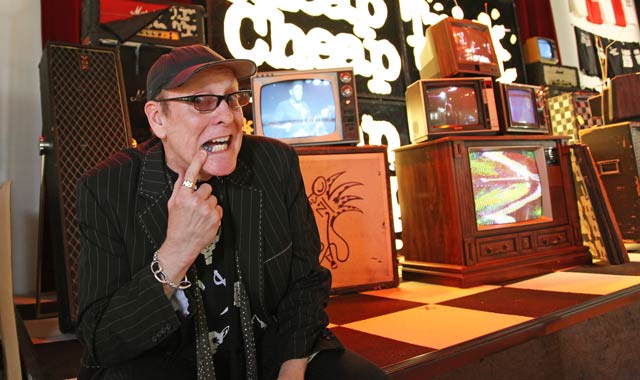Rick Nielsen’s amazing collection of guitars and Cheap Trick memorabilia come out for a brand-new, traveling exhibit. See it first at this small museum in Illinois.

Jane, the 66 million-year-old juvenile T. rex dinosaur, isn’t the only star inhabiting Burpee Museum of Natural History in downtown Rockford these days.
A sprawling 3,000-piece collection of guitars and memorabilia owned by Cheap Trick’s Rick Nielsen, called “Rick’s Picks: Rick Nielsen’s Lifelong Affair with Guitars and Music,” recently debuted in Woodward Hall, the shiny new top-notch exhibit space shared by Burpee and Discovery Center Museum, 737 N. Main St.
When Burpee first approached Nielsen with the idea, the 63-year-old rock star joked, “Sure, the museum needs one more dinosaur. My kids and grandkids think I’m a fossil, too.”
In Rockford until April, the exhibit will tour other U.S. cities, and possibly London and Tokyo, next.
“I feel like I’m on ‘This is Your Life,’ and that Ralph Edwards is going to come down any minute,” Nielsen marveled, while leading an opening day tour through artifacts from his remarkable life. “Most of the time, people only do this for you when you’re dying, so this is really nice. By the way, this was not my idea. Sure, I collected all this crap – I mean nice stuff – but other people put it all together here so beautifully. My wife is just thrilled that it’s finally out of the garage. She threatened to sign me up for that TV show about hoarders.”
That Nielsen and wife Karen have remained in Rockford, raising four children in the city during 40-plus years of marriage, is all the more impressive because of his rocky relationship with Rockford’s public school district as a child. He was permanently booted from its music program in 7th grade.
“I told the music teacher he was an incompetent, drunken fool who didn’t deserve to teach music to me or anyone else,” says Nielsen. In school, he had played first chair flute and drums, but by the time he was 12, the guitar was his instrument. He developed an unconventional style well suited to stage performance, but he considers songwriting his first talent.
“I don’t have to look at the guitar when I play,” he says. “That way, I can look at the audience or the pretty girls or whatever I want to look at.”
The only child of the late Ralph and Marilyn Nielsen, accomplished musicians who ran a downtown Rockford music store, Nielsen found himself just as bored and frustrated by the pop music he heard on 1960s radio as he was by the school’s music curriculum.
“We didn’t have the Internet or access to other kinds of music then, but I listened to the weekly radio broadcast of Top 10 from England,” he recalls. “I was driving my car the first time I heard Jimi Hendrix play, and I had to pull off the road.”
That defining moment, along with other events, led him to form and evolve Cheap Trick in the early ’70s, with bassist Tom Petersson, vocalist Robin Zander and drummer Bun E. Carlos. Before the punkish, hard-edged band had even recorded its first album, it became a sensation in Japan, soon outranking Queen and KISS, the mega-bands for which it had opened.
Many pieces of Japanese fan mail are part of the Rick’s Picks collection, as are 55 gold and platinum records, 100 show posters, 50 pairs of sunglasses, 16 sweaters designed by Nielsen, plenty of objects related to other celebrities, 170 Rick-designed guitar picks, a black and white ’55 Thunderbird, Nielsen’s checkered John Deere lawn tractor/snowplow, the original illuminated Cheap Trick stage backdrop and, of course, 73 of the 2,000 guitars Nielsen has owned, including one of three signature five-necks made by Hamer. Nielsen still wields the massive instrument onstage when playing “Surrender.”
“I thought, if we’re gonna look stupid, let’s look very stupid,” says Nielsen, recalling his first vision for the five-neck. “I told Hamer that every neck has to work and each has to be unique – one is fretless, one has a whammy bar. It was a ridiculous thing to ask for, sort of like saving more than 5,000 boarding passes is ridiculous. But I like giving an audience the impossible, and I have long arms, so I can play it. A few days ago, after a show, Johnny Depp came backstage and asked to play it. I thought, ‘That’ll teach you to try to do what I do.’ My wife and I got a photo with him, but she Photoshopped me out of it.”
It’s these colorful bits of a unique life that make the Rick’s Picks exhibit so much fun, and provide clues to a man with far more depth than his flippant wit belies.
“People who write great rock songs are people who actually have an inner life that’s worth exploring,” rock critic Ira Robins says of Nielsen, in a taped interview that’s part of the exhibit. “He’s a guy who has to be exactly who he is every minute of the day.”
Glimpses of that rich inner life are on display in the form of old cocktail napkins and other paper scraps under glass. Scratched on one is a prayer; on others, the first words that developed into hits “Dream Police” and “Surrender.”
“To me, the F-word is ‘finish,’” says Nielsen. “It’s why I keep scraps of paper, some for decades. I get an idea for a song, maybe it’s in the middle of the night, and I write down words. Some of them don’t mean anything to me years later – ‘chocolate milk,’ what did that mean? But some turn into songs. I’m a songwriter who happens to play the guitar.”
Not so fast, says Robins, who ranks Nielsen among the best of all ax players. “If he set out to be the world’s greatest guitar player, he shot himself in the foot by making it look so easy.”
Music isn’t Nielsen’s only talent. He admits to having “a knack for acquiring things that other people think are junk,” like the 1955 Les Paul guitar he bought in 1965 from a Rockford bookstore for $65, now worth tens of thousands of dollars.
“But I never did that stuff for money,” he says. “I’m a musician. I’m supposed to be poor. If I thought a guitar had mojo – some other guy had played it and had given it a ‘cool factor’ – I bought it. And I used the guitars I bought. I never park my car in the far end of the parking lot, you know? If it gets scratched, it gets scratched. I respect a guitar that looks a little beat up from use. It’s like a work of art to me. Everything I bought was used. You shouldn’t spend money on art just to make money. You should buy it because you like it. It’s the same with guitars.”
And with life.
“I chose a music career because I love to play music. I didn’t do it to make money and I didn’t do it to please anybody but myself. I’ve been playing since I was 12, just because I love it. I still love it, still want to do it, never want to retire.”
To learn more about “Rick’s Picks: A Lifelong Affair with Guitars & Music,” go to burpee.org.




















































